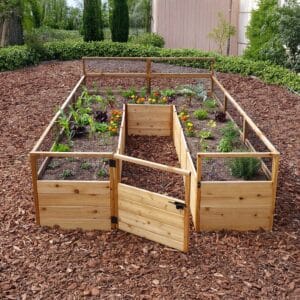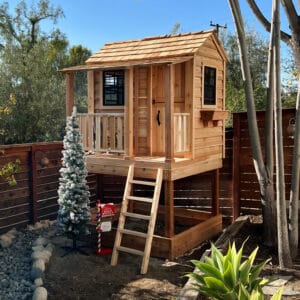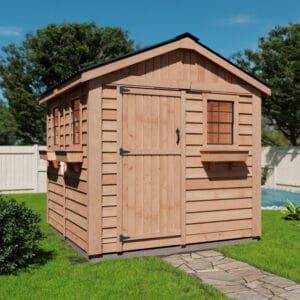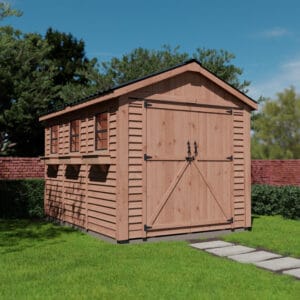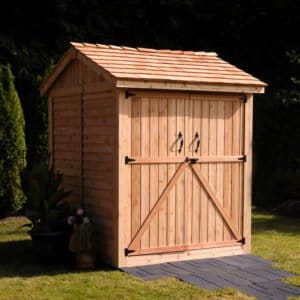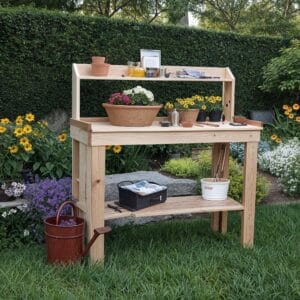No products in the cart.
January 25, 2015
 The most important feature when constructing a garden or storage shed is to start off with a solid level base. There is no guarantee that your backyard or garden space will be completely level despite looking reasonably so.This may not be an issue for many people, but if you are going to have a working bench inside the shed, where you plan to spend much of your hobby time, it is important that the bench is sitting level and not tilted at an angle. Without any doubt, no one would appreciate dining every day at a table that is inclined at an odd angle. You do not want your milk spilled on your lap, you want it sitting just fine in your cup.A Potential Colossal Error Most importantly, to make it easy to assemble the shed, the base has to be completely level. In case the base is off level, it will only start showing when you get to the point when you have to start assembling the roof and you start running into all sorts of trouble because of the level issues.The easiest way to guarantee that your floor will be level is to buy a few tons of aggrade or crushed stone from your local hardware store. Crushed stone aggregate is a mixture of small stones and fine dust. This mixture after due leveling and compacting will offer the same strength as concrete because the stone will bind into the fine dust and provide the perfect base for your shed’s floor.Setting OutYou can begin by marking the levels of the place where you plan to put up your shed. After this is done, drive four small 2’ wooden pegs with spiked edge at one end into the ground at approximately four points that will approximately be the four corner points of your shed. You will need to make your base a little bigger than the base of the shed. It will be a prudent idea to ponder awhile on how your shed is going to look like. Will it be imposing or is it going to obstruct the view or maybe end up blocking light?Only when you are satisfied about the exact position where you want your shed to come up should you move on to the next stage. The next thing is to create four level points at the four corner positions and mark them on the four pegs you hammered into the earth. Later on, if necessary, you can cut the stake down while they are still moored well enough in the earth up to these level points.The simplest way of achieving this is to identify which you think is the highest corner in the space and hammer than peg in the ground, to about 4 – 6 inches of the existing ground level. By doing this you have ensured that the top of the peg sits 4/6” above ground. This exercise is meant to find an average height that would be suitable for all four corners without using too much aggregate.There are several ways of controlling an excavation. But this one being a small excavation, a spirit level used together with a long (8′ or 2.4m) 4×2 timber will be fine. You can use a spade to strip the turf and top soil to a depth of 50mm and then excavate to the depth of 75mm in one corner. Resting the end of the 4×2 on the corner peg, measure down to ground level. It would be prudent if you could cut a piece of timber of this length. You can then take your excavation forward, checking with the 4×2, the spirit lamp and the timber that you are not going too deep.Placing Crushed Stone Layer Before you have compacted the stones, rake it as level as possible. To compact the stone you could hire a vibrating plate, but if you need to burn those extra calories you can use a hand tamper to compact the ground. Hand tampers are 25 lbs in weight with an area of 4”x4” which you raise repeatedly and let it fall to compact the stone. Keep pounding the stone into the earth until it is compacted and at the same time keep taking levels as you did while excavating. Add or remove the aggrate according to the requirement.Pressure Treated Wood FoundationIt is necessary to ensure that the timbers are laid perpendicular to the direction of the floor joists. The pressure treated timbers should be 4”x4”, to permit ventilation under the shed. Usually pressure treated timber has a long lifespan when in contact with the ground but installing the weed barrier and the stone should prolong it further. Moisture is what leads to decay, so remember that any steps taken to ensure dryness will prolong the life of the timber.
The most important feature when constructing a garden or storage shed is to start off with a solid level base. There is no guarantee that your backyard or garden space will be completely level despite looking reasonably so.This may not be an issue for many people, but if you are going to have a working bench inside the shed, where you plan to spend much of your hobby time, it is important that the bench is sitting level and not tilted at an angle. Without any doubt, no one would appreciate dining every day at a table that is inclined at an odd angle. You do not want your milk spilled on your lap, you want it sitting just fine in your cup.A Potential Colossal Error Most importantly, to make it easy to assemble the shed, the base has to be completely level. In case the base is off level, it will only start showing when you get to the point when you have to start assembling the roof and you start running into all sorts of trouble because of the level issues.The easiest way to guarantee that your floor will be level is to buy a few tons of aggrade or crushed stone from your local hardware store. Crushed stone aggregate is a mixture of small stones and fine dust. This mixture after due leveling and compacting will offer the same strength as concrete because the stone will bind into the fine dust and provide the perfect base for your shed’s floor.Setting OutYou can begin by marking the levels of the place where you plan to put up your shed. After this is done, drive four small 2’ wooden pegs with spiked edge at one end into the ground at approximately four points that will approximately be the four corner points of your shed. You will need to make your base a little bigger than the base of the shed. It will be a prudent idea to ponder awhile on how your shed is going to look like. Will it be imposing or is it going to obstruct the view or maybe end up blocking light?Only when you are satisfied about the exact position where you want your shed to come up should you move on to the next stage. The next thing is to create four level points at the four corner positions and mark them on the four pegs you hammered into the earth. Later on, if necessary, you can cut the stake down while they are still moored well enough in the earth up to these level points.The simplest way of achieving this is to identify which you think is the highest corner in the space and hammer than peg in the ground, to about 4 – 6 inches of the existing ground level. By doing this you have ensured that the top of the peg sits 4/6” above ground. This exercise is meant to find an average height that would be suitable for all four corners without using too much aggregate.There are several ways of controlling an excavation. But this one being a small excavation, a spirit level used together with a long (8′ or 2.4m) 4×2 timber will be fine. You can use a spade to strip the turf and top soil to a depth of 50mm and then excavate to the depth of 75mm in one corner. Resting the end of the 4×2 on the corner peg, measure down to ground level. It would be prudent if you could cut a piece of timber of this length. You can then take your excavation forward, checking with the 4×2, the spirit lamp and the timber that you are not going too deep.Placing Crushed Stone Layer Before you have compacted the stones, rake it as level as possible. To compact the stone you could hire a vibrating plate, but if you need to burn those extra calories you can use a hand tamper to compact the ground. Hand tampers are 25 lbs in weight with an area of 4”x4” which you raise repeatedly and let it fall to compact the stone. Keep pounding the stone into the earth until it is compacted and at the same time keep taking levels as you did while excavating. Add or remove the aggrate according to the requirement.Pressure Treated Wood FoundationIt is necessary to ensure that the timbers are laid perpendicular to the direction of the floor joists. The pressure treated timbers should be 4”x4”, to permit ventilation under the shed. Usually pressure treated timber has a long lifespan when in contact with the ground but installing the weed barrier and the stone should prolong it further. Moisture is what leads to decay, so remember that any steps taken to ensure dryness will prolong the life of the timber.January 25, 2015
-
 On SaleSale!%Off25Save $756756$25%756$On SaleSale!%Off25Save $763763$25%763$On SaleSale!%Off25Save $681681$25%681$On SaleSale!%Off25Save $521521$25%521$On SaleSale!%Off25Save $763763$25%763$
On SaleSale!%Off25Save $756756$25%756$On SaleSale!%Off25Save $763763$25%763$On SaleSale!%Off25Save $681681$25%681$On SaleSale!%Off25Save $521521$25%521$On SaleSale!%Off25Save $763763$25%763$ -
 On SaleSale!%Off24Save $977977$24%977$On SaleSale!%Off24Save $977977$24%977$
On SaleSale!%Off24Save $977977$24%977$On SaleSale!%Off24Save $977977$24%977$ -
 On SaleSale!%Off6Save $339339$6%339$On SaleSale!%Off2Save $8080$2%80$On SaleSale!%Off6Save $251251$6%251$On SaleSale!%Off6Save $339339$6%339$
On SaleSale!%Off6Save $339339$6%339$On SaleSale!%Off2Save $8080$2%80$On SaleSale!%Off6Save $251251$6%251$On SaleSale!%Off6Save $339339$6%339$ -
 On SaleSale!%Off13Save $930930$13%930$On SaleSale!%Off7Save $445445$7%445$On SaleSale!%Off7Save $400400$7%400$On SaleSale!%Off13Save $930930$13%930$
On SaleSale!%Off13Save $930930$13%930$On SaleSale!%Off7Save $445445$7%445$On SaleSale!%Off7Save $400400$7%400$On SaleSale!%Off13Save $930930$13%930$ -
 On SaleSale!%Off13Save $540540$13%540$On SaleSale!%Off13Save $550550$13%550$On SaleSale!%Off12Save $445445$12%445$On SaleSale!%Off13Save $550550$13%550$
On SaleSale!%Off13Save $540540$13%540$On SaleSale!%Off13Save $550550$13%550$On SaleSale!%Off12Save $445445$12%445$On SaleSale!%Off13Save $550550$13%550$ -
 On SaleSale!%Off26Save $130130$26%130$On SaleSale!%Off26Save $130130$26%130$
On SaleSale!%Off26Save $130130$26%130$On SaleSale!%Off26Save $130130$26%130$

